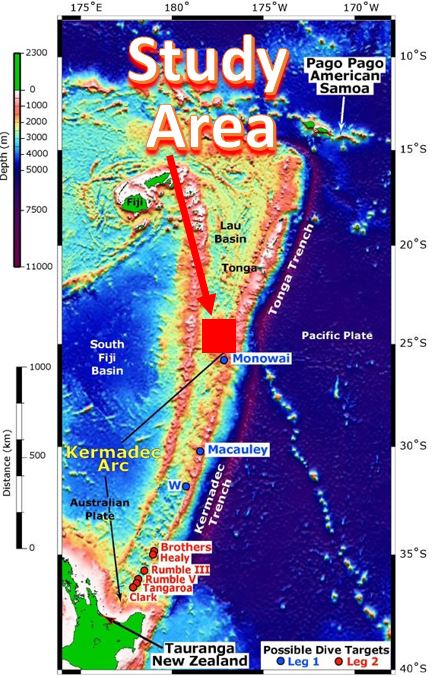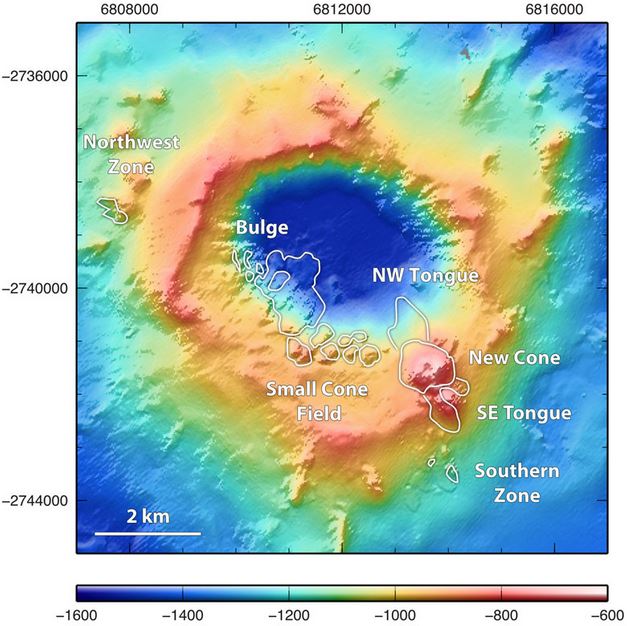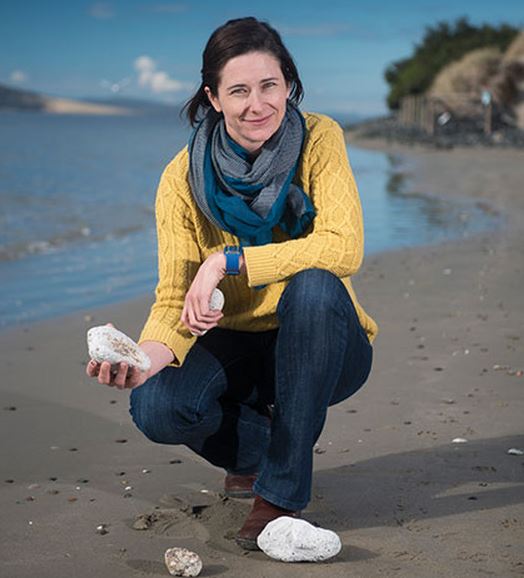Rafts of pumice have been washing up on Tasmanian beaches since March 2014, when Dr. Rebecca Carey started receiving phone calls and emails from curious members of the public. The porous rocks have also been washing up along the coasts of New Zealand and other parts of Australia.
The pumice – a light, porous volcanic rock formed when magma solidifies – came from a massive submarine volcanic eruption that started in August 2012, approximately 1000 km (621 miles) north of Auckland.
The pumice travelled 4000km across the Pacific Ocean to arrive in Tasmanian waters 18 months later.

Dr. Carey aboard US research vessel the Roger Revelle. (Image: Australian Maritime College)
Last year, Dr. Carey, a volcanologist who works at the School of Earth Sciences and CODES, University of Tasmania, said:
“We knew that this pumice was going to arrive in Tasmania, but we didn’t know exactly when.”
Dr. Carey and scientists from Queensland University of Technology had been tracking the pumice via satellite imagery, as well as reports from several communities along the Australian eastern seaboard. Last year, she initiated a community-wide research project tracking the porous rocks down the east coast of Tasmania.
The eruptions produce giant pumice clusters (pumice ‘rafts’) which can travel around the Earth for decades. They gradually acquire marine life, such as bristle worms and barnacles. “Like hitchhikers, the biology is transported between continents and islands. With time, the accumulation of marine biology and its growth will get so heavy it actually sinks the pumice,” Dr. Carey explained.
The researchers were able to identify areas of high loss or gain of newly erupted material on the volcano and work out the volume of new pumice on the sea floor. More than ten volcanic centres up to 1,400 metres below sea level were related to the 2012 eruption.
Uncommon and powerful eruptions
Dr. Carey said:
“It’s not easy for magma to erupt explosively from these depths – only the most energetic eruptions can do so, and hence we think that this is likely a one per century event.”
Last year, the scientists submitted a proposal to the US National Science foundation for an expedition to the volcano site and were awarded a US$720,000 grant.
Dr. Carey and an international group of scientists are about to board a ship carrying two underwater robots called ‘Jason’ and ‘Sentry’ to learn more about the volcanic eruptions at the Havre Seamount (Havre) in the Kermadec region.
They will board US ship Roger Revelle, with Dr. Carey as Co-Chief Scientist of the Mapping Exploration and Sampling at Havre (MESH). The ship is named after Roger Randall Dougan Revelle (1909-1991), an American scientist and scholar. He was one of the first scientists to study global warming and the movement of Earth’s tectonic plates.

The Kermadec region extends from New Zealand’s North Island to Samoa. (Image: Wikimedia)
The Robots
Two robots will be assisting the researchers and allowing them to carry out their study without having to get wet all the time.
Jason, which can be operated remotely, will give the scientists access to the seafloor without having to leave the ship. It will collect samples of sediment, marine life and rock, as well as transmit images and video.
Sentry, equipped with sonars – it guides itself like a submarine. It can also take digital photographs.
Dr. Carey, who described this voyage of the sea floor as ‘a new frontier’, explained:
“That is exciting in itself, but the Havre eruption is very interesting in that it challenges current controversies in submarine volcanism.”
“For example, theory predicts eruptions of this magma type should not be explosive at about a 1000 metres below sea level. This eruption was sourced from multiple vents that extend maybe as deep at 1600 metres but as shallow as 900 metres- so this eruption is contradicting that theory.”

The Havre Seamount is 640 to 900 meters below sea level (250 meters high). It is 1.2 kilometers across. Its summit crater has a diameter of 120 meters. (Image: Woods Hole Oceanographic Institution)
Water and volcanic eruptions
The scientists also want to learn more about the role played by water in volcanic eruptions.
Dr. Carey said:
“When the gas and pumice come out of the volcano’s vents, what is the role of water in transporting pumice to the sea surface? Or back down to the sea floor to form dense flows of pumice?”
“We are also interested in how those pumice particles are transported once they leave the vent.”

Dr. Carey with some pumice stones that were washed up on the beach in Tasmania. (Image: University of Tasmania)
The expedition has educational value
The study has significant educational value, the researchers say. It is partly supported by the Bookend Trust, a “not-for-profit education initiative that seeks to inspire students and their communities with the positive environmental careers they can build making the world a better place.”
Dr. Carey said:
“We have a website which will report our activities and findings in real time, by posting photos of everyday life on the ship and videos of the footage the robots recover.”
“School children are encouraged to follow our voyage online and they will be able to ask the scientists questions.”
After the research voyage is over, an educational program based on the trip will be created, including what has been discovered. Dr. Carey explained “allowing schoolchildren to learn all about volcanology and global plate tectonics through the exciting lesson plans.”
Pumice rafts carry organisms across the ocean
The researchers believe that pumice rafts may have been the transport mechanism that carried several types of biology across the Earth hundreds of millions of years ago.
Dr. Carey said:
“This theory could explain why different continents can have the same marine and terrestrial species.”
Dr Simon Grove, Senior Curator of Invertebrate Zoology at the Tasmanian Museum and Art Gallery, who became interested in Dr. Carey’s research, said:
“From Flinders Island in the north to Bicheno in the east, I found some molluscan hitchhikers that had not been recorded previously in Tasmanian waters.”
“The main one was a tiny snail called Litiopa limnophysa, which seems to specialise in grazing algae on floating objects such as pumice.”
“Two species of pearl oysters have also been turning up. Neither these nor the Litiopa would be expected to survive under Tasmanian conditions, but it was interesting that they could disperse so readily on pumice this far south.”
NASA Video – Pumice Rafts
